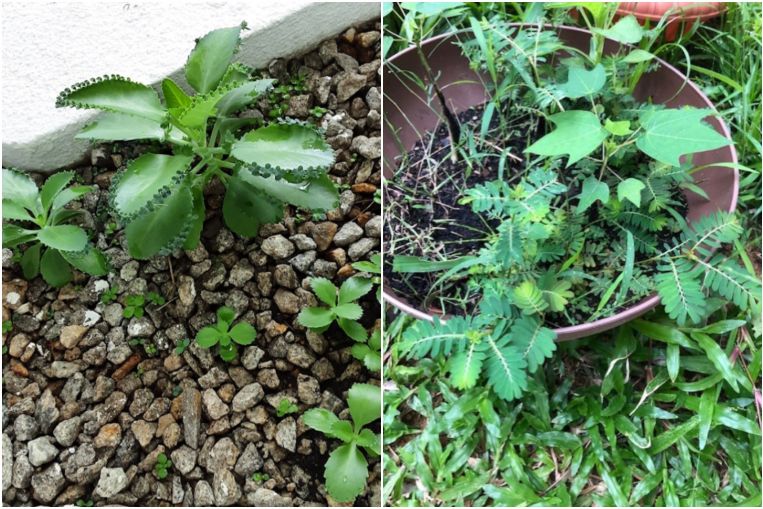Mother of Thousands can behave like a weed
I found a small green plant in the planter of my apartment a few weeks ago. With some care, it grew and I later noticed it carried many babies on the edges of its leaves. I spread the babies around and now have a plot of them. What is it?
Eng Wang Moi
The plant is a species of succulent botanically known as Kalanchoe laetivirens. Its common name is Mother of Thousands, due to the numerous baby plants it is capable of producing at the notches along the leaf margins. This species can become quite weedlike over time.
Weed species is a medicinal plant
I started gardening recently. Every time I plant seeds, I get surprise seedlings which seem to sprout everywhere.
What are these fern-like plants? Were the seedlings “gifted” by visiting birds? Should I remove the plants to prevent overcrowding?
Pauline Leong
The weed could be Phyllanthus urinaria or Phyllanthus amarus. Both species look similar and are valued as medicinal herbs.
The plant propagates itself readily via fruit, which it produces in abundance under its leaves. It is deeply rooted and can be difficult to remove.
Diligent hand-weeding of seedlings before plants mature is the chemical-free way to remove unwanted plant infestations.
Pomegranate plant may have been burnt by neem oil

Is my plant lacking in nutrients, sunlight or water? Or is it sick?
I apply neem oil to its leaves in the evening, but the brown and black patches seem to be appearing more often. I see new leaves and branches growing, and the plant receives direct sunlight in the afternoon.
Jessica Heng
Your pomegranate plant (Punica granatum) may have been burnt by the neem oil applied to its leaves.
Oil-based pesticides need to be applied with care. Before applying, spray the oil on a small part of the plant to ensure no adverse reaction. It is best to spray during a cooler time of day, without direct sunlight shining on the plant after application.
The black spots could be due to injury from the neem oil application. You may need to further dilute the neem oil solution before spraying or use another pesticide.
The pomegranate plant needs at least six hours of direct sunlight and well-drained soil to thrive. A lack of sunlight, coupled with wet roots, can cause it to decline.
Plants are cultivars of Plectranthus and Alternanthera

What are these plants and are they edible?
Ng Kee Seng
The first plant is an unidentified Plectranthus species. It is a relative of the medicinal herb, Indian borage (Plectranthus amboinicus) and the weed, Monkey’s Potato (Plectranthus monostachyus).
The second plant is a cultivar of Alternanthera ficoidea. It is a relative of the leafy vegetable, Brazilian spinach (Alternanthera sissoo) and the medicinal plant, Sessile Joyweed (Alternanthera sessilis).
However, despite their possible relation to common edible plants, avoid consuming unknown plants.
Crown Flower’s leaves are food for caterpillars

I saw this plant in East Coast Park. What is it and is it poisonous?
Abby Yang
The plant is botanically known as Calotropis gigantea and its common names include Crown Flower and Giant Milkweed.
It is a popular plant in ecological gardens, as the leaves are food for the caterpillars of the Plain Tiger and Common Crow butterflies, which are important pollinators. Like many plants in the frangipani family (Apocynaceae), this plant’s milky sap is toxic. Avoid coming into contact with the sap or consuming any of its other parts.
Seven Star Needle, Black Face General are medicinal plants; Hoya is ornamental plant

What are these plants? Do they have any benefits?
Fiona Kwan
The first plant is botanically known as Leuenbergeria bleo and is locally called the Seven Star Needle. It is a leafy cactus species that produces fleshy leaves and orange flowers. Its leaves are used in Malaysian folk medicine to treat cancer, rheumatism and ulcers.
The second plant is locally known as the Black Face General. Its botanical name is Strobilanthes crispa. It grows as a shrub with rough leaves. Mature plants produce yellow flowers. In folk medicine, the leaves are used to treat cancer, diabetes, jaundice, haemorrhoids and ulcers.
These two plants are commonly planted in local medicinal gardens. Do not self-medicate without the guidance of a certified practitioner.
Lastly, the plant producing a cluster of star-shaped flowers is the species Hoya, also known as wax flowers. They generally grow as climbing vines and many species produce scented flowers. These ornamental plants grow best in moist and aerated media consisting of coconut husk chunks. Depending on the species, they fare best in a location with filtered sunlight.
• Have a gardening query? E-mail it with clear, high-resolution pictures of at least 1MB, if any, and your full name to stlife@sph.com.sg. We reserve the right to edit and reject questions.
• Answers by Dr Wilson Wong, an NParks-certified practising horticulturist, parks manager and ISA-certified arborist. He is the founder of Green Culture Singapore and an adjunct assistant professor (Food Science & Technology) at the National University of Singapore.













































